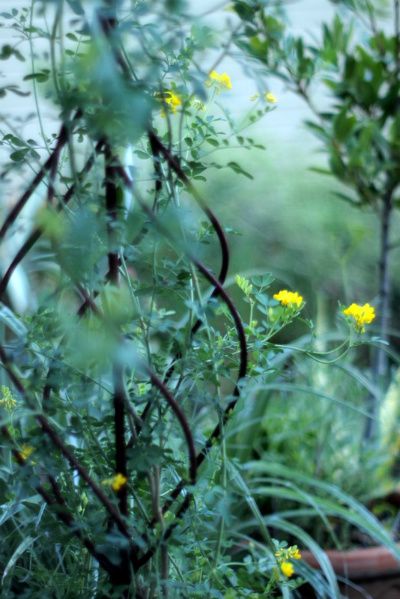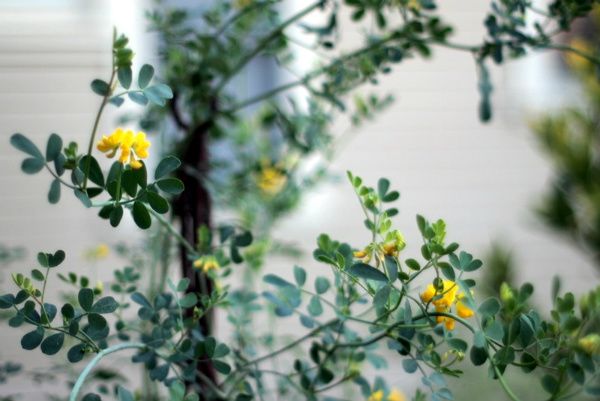
My dainty coronilla reminds me of Cytisus battandieri a little bit, which is another member of the vast legume family. All legumes have the ability to convert and “fix” atmospheric nitrogen, making it available to plants as a natural fertilizer.
“Although it is the most abundant element in the atmosphere, nitrogen from the air cannot be used by plants until it is chemically transformed, or fixed, into ammonium or nitrate compounds that plants can metabolize. In nature, only certain bacteria and algae (and, to a lesser extent, lightning) have this ability to fix atmospheric nitrogen, and the amount that they make available to plants is comparatively small. Other bacteria break down nitrogen compounds in dead matter and release it to the atmosphere again. As a consequence, nitrogen is a precious commodity a ‘limiting nutrient’ in most undisturbed natural systems.” (“Nutrient Overload; Unbalancing the Global Nitrogen Cycle” – World Resources Institute)
I caught a report Thursday on nitrogen runoff by Public Radio International’s The World: “Nitrogen compounds running off farmland have led to water pollution problems around the world, while nitrogen emissions from industry, agriculture and vehicles make a big contribution to air pollution.” (“Farms, Factories, and a Dangerous Nitrogen Overload,” by Laura Lynch, 1/26/12.)
Vast ocean “dead zones” are linked to runoff from agricultural reliance on nitrogen, especially in support of King Corn, but excess fertilizer polluting waterways comes from many sources. Last spring a local marina experienced a dramatic fish die-off, reported here by The Los Angeles Times (“The episode…follows unusually heavy rainfall in Southern California, which washed lawn fertilizer, dog droppings and similar nutrients into coastal waters.”)
Fertilizers have been quite the topic of discussion on blogs this week.

The National Wildlife Federation really kicked the hornet’s nest when they announced they’d accepted corporate sponsorship from Scotts of Miracle-Gro and Roundup herbicide fame. The move seemed cynically calibrated to upgrade Scotts image and shore up dwindling sales/contributions of both entities. But at what cost now to NWF’s brand, which is experiencing near-extinction overnight? I suppose both sides are betting that the controversy will be forgotten by the public by the time NWF’s friendly logo appears on Scotts’ bags of bird seed. The public does have an infamously short memory, but will it really be able to forget that Scotts was fined millions of dollars for knowingly selling pesticide-tainted birdseed between 2005-2008? On the surface, it looks like both sides have garnered a big lose/lose out of the transaction. The question now becomes, what did NWF know about the tainted birdseed, and when did they know it?
According to reporter Johanna Hari, this isn’t the first instance of such a partnership, and she alleges that the beginning of similar conflicts of interest can be traced back to Jay Hair, president of the National Wildlife Federation from 1981 to 1995: “It is simply a fact that Jay Hair kick-started the process of environmental groups partnering with and taking money from the world’s worst polluters. It is also a fact that this process has been taken much further by other groups like Conservation International and The Nature Conservancy, and has ended with their missions becoming deeply corrupted, in ways I described in great detail in my article.” (The Nation, 3/10/10. “Conservation Groups & Corporate Cash: An Exchange.”)
How much fertilizer my garden needs is a constant mystery to me. Some years I’m convinced I’ve “exhausted” the soil. Still, it basically gets only compost, rarely some blood and bone meal, but then I don’t grow many vegetables or prize-winning flowers either. Admittedly, dahlias are having a comeback in my garden, and they are hogs for manure and compost.
The merits and demerits of the Green Revolution will be argued for decades to come. In ratcheting up agricultural productivity to fight hunger, the GE’s downstream effects have been nitrogen pollution and unsustainable agricultural practices — leaving me, the home gardener, feeling altogether ambivalent about fertilizer. I realize that what I choose to do in my tiny garden doesn’t really amount to a hill of beans when compared to the practices of agribusiness. Even so, mostly I just say no to fertilizers and don’t grow plants bred to expect lavish amounts of the stuff.


Locally, excess nitrogen (primarily from lawns) has had the effect of promoting the blooming of red tides each summer in my river. This past August I invited the wrath of the Virginia Turfgrass Council by writing a letter to the editor of the newspaper that the executive director of the VTC quickly deemed to have an “anti-turfgrass bias”, a badge I wear with honor.
Les, and so you should — well done!
(Since Les mentioned it, I’m linking to his blog post “Red Tide Green Lawns”: http://atidewatergardener.blogspot.com/2011/09/red-tide-green-lawns.html)